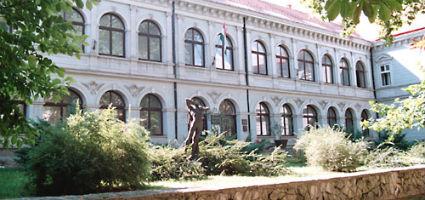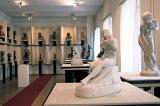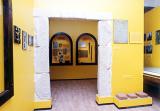2025. July 19. Saturday
Göcsej Museum - Zalaegerszeg
 |
Address: 8900, Zalaegerszeg Batthyány utca 2.
Phone number: (92) 346-736
E-mail: muzeum@gocsejimuzeum.hu
Opening hours: 11.01-31.03.: Tue-Sat 9-17
01.04-31.10.: Tue-Sun 10-18 |
The idea of building a museum was first announced in 1989 in an article written by the teacher Borbély György. In 1907, the teachers of the Grammar School began to collect old objects of ethnography. Most of them were scattered at the time of WWI, the rest were taken to Keszthely. In 1935, the keeper of records Fára József began to organize another museum that resulted in the foundation of the Göcseji Collection.
The Museum of Göcsej was realized in two wards of the Town Hall in 1950. Its first professional worker was the ethnographer Szentmihályi Imre until 1969.
In the first decade the folk traditions, agriculture and interiors of houses of Göcsej were in focus. The collection of old tools of shepherds and farmers was very successful.
The thousands of photos about the traditional life in the village taken by Szentmihályi were very important for the oncoming research works. The first independent exhibition opened in 1950. In 1960, the Jubilee Book of the Museum of Göcsej was published with many essays on the history of the county.
In 1962, the institution was taken over by the County Council. For some time two archeologists, (1962-63 Valter Ilona, 1967-69 Müller Róbert) worked there, but left soon for the unfavorable circumstances.
The Village Museum of Göcsej was begun to be built in 1963. The plan of the open air exhibition was made by the professor Barabás Jenő, the ethnographer Szentmihályi Imre and the architect Tóth János. The large-scale work required a large number of workers, thus a work committee was formed to help the procedure. Hungary's first open-air museum opened on 20, August 1968. Three of the like opened in the next decade in Kávás, Csesztreg, Zalalövő.
The museum received a building in a very bad state. The reconstruction works were finished in 1973 and new temporary exhibitions opened. In the meantime, the Museum Association of Zala County was formed and the Museum of Göcsej became a county museum. In 1976, the Kisfaludi Strobl Collection opened of the works of the artist. In 1979, the permanent exhibition titled 'The History of Zala County' opened. It is mainly field became archeology. The museum worked together with the National Monument Guard and the Archeology y Department of ELTE. In 1978, the preparation works for the research of the Small Balaton began which became one of the biggest excavation works in the country. The Hahóti Base was researched similarly. The international relations especially with Austria are very fruitful. Our employees publish their works in several periodicals.
The building of the museum was reconstructed again after 1992. Modern studios were formed in the attic while space was liberated for modern storages.
The Museum of Göcsej was realized in two wards of the Town Hall in 1950. Its first professional worker was the ethnographer Szentmihályi Imre until 1969.
In the first decade the folk traditions, agriculture and interiors of houses of Göcsej were in focus. The collection of old tools of shepherds and farmers was very successful.
The thousands of photos about the traditional life in the village taken by Szentmihályi were very important for the oncoming research works. The first independent exhibition opened in 1950. In 1960, the Jubilee Book of the Museum of Göcsej was published with many essays on the history of the county.
In 1962, the institution was taken over by the County Council. For some time two archeologists, (1962-63 Valter Ilona, 1967-69 Müller Róbert) worked there, but left soon for the unfavorable circumstances.
The Village Museum of Göcsej was begun to be built in 1963. The plan of the open air exhibition was made by the professor Barabás Jenő, the ethnographer Szentmihályi Imre and the architect Tóth János. The large-scale work required a large number of workers, thus a work committee was formed to help the procedure. Hungary's first open-air museum opened on 20, August 1968. Three of the like opened in the next decade in Kávás, Csesztreg, Zalalövő.
The museum received a building in a very bad state. The reconstruction works were finished in 1973 and new temporary exhibitions opened. In the meantime, the Museum Association of Zala County was formed and the Museum of Göcsej became a county museum. In 1976, the Kisfaludi Strobl Collection opened of the works of the artist. In 1979, the permanent exhibition titled 'The History of Zala County' opened. It is mainly field became archeology. The museum worked together with the National Monument Guard and the Archeology y Department of ELTE. In 1978, the preparation works for the research of the Small Balaton began which became one of the biggest excavation works in the country. The Hahóti Base was researched similarly. The international relations especially with Austria are very fruitful. Our employees publish their works in several periodicals.
The building of the museum was reconstructed again after 1992. Modern studios were formed in the attic while space was liberated for modern storages.

